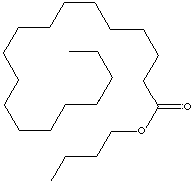PRODUCT IDENTIFICATION

H.S. CODE
TOXICITY
CLASSIFICATION
PHYSICAL AND CHEMICAL PROPERTIES
Health: 0 Flammability: 1 Reactivity: 0
Stable under ordinary conditions
GENERAL DESCRIPTION & EXTERNAL LINKS
Wikipedia Linking:http://en.wikipedia.org/wiki/Stearic_acid
http://sitem.herts.ac.uk/
Environmental
Fate - Ecotoxicology - Human Health - A to Z Index - Home - FOOTPRINT
http://www.cosmeticsinfo.org/
Why is it used in cosmetics and personal care products?:
Stearate esters act
primarily as lubricants on the skin��s surface, which gives the skin a soft and
smooth appearance. Butyl Stearate also decreases the thickness of lipsticks,
thereby lessening the drag on lips, and imparts water repelling characteristics
to nail polishes. Butyl Stearate and Isopropyl Stearate dry to form a thin
coating on the skin. Isocetyl Stearate can also be used to dissolve other
substances, usually liquids.
http://www.3dchem.com/
Stearic acid comes from many animal and vegetable fats and oils. It is a waxy
solid. Its name comes from the Greek word stéar (genitive: stéatos), which means
tallow. Stearic acid is useful as an ingredient in making candles, soaps,
plastics, oil pastels and cosmetics, and for softening rubber. Stearic acid is
used to harden soaps, particularly those made with vegetable oil. Fatty acids
are a carboxylic acid with a long unbranched aliphatic tail (chain), which is
either saturated or unsaturated. Fatty acids derived from natural fats and oils
may be assumed to have at least 8 carbon atoms. Most of the natural fatty acids
have an even number of carbon atoms, because their biosynthesis involves
acetyl-CoA, a coenzyme carrying a two-carbon-atom group...
APPEARANCE
ESTER CONTENT
98.0% min
SAP VALUE
25 max
GENERAL DESCRIPTION OF FATTY ACID